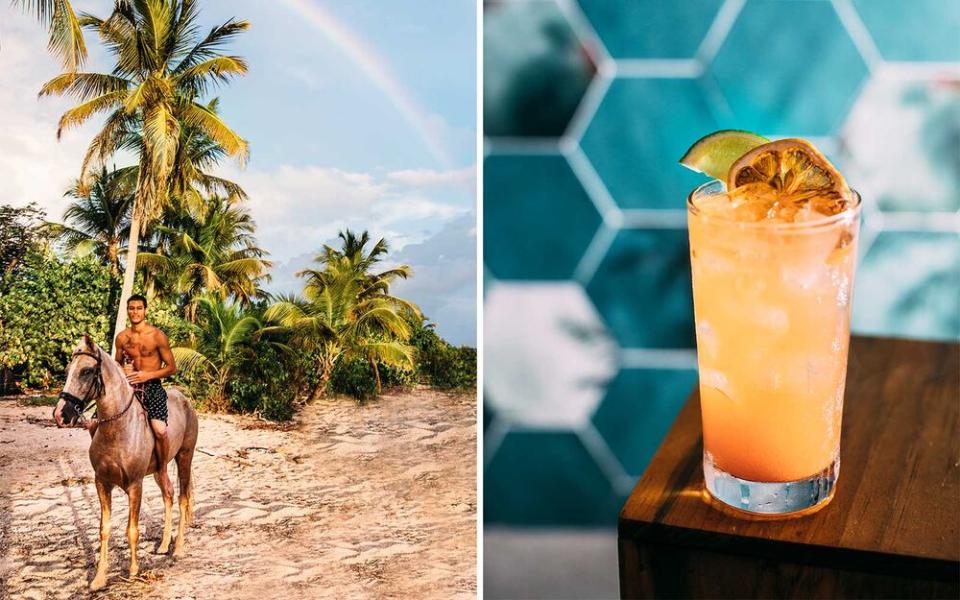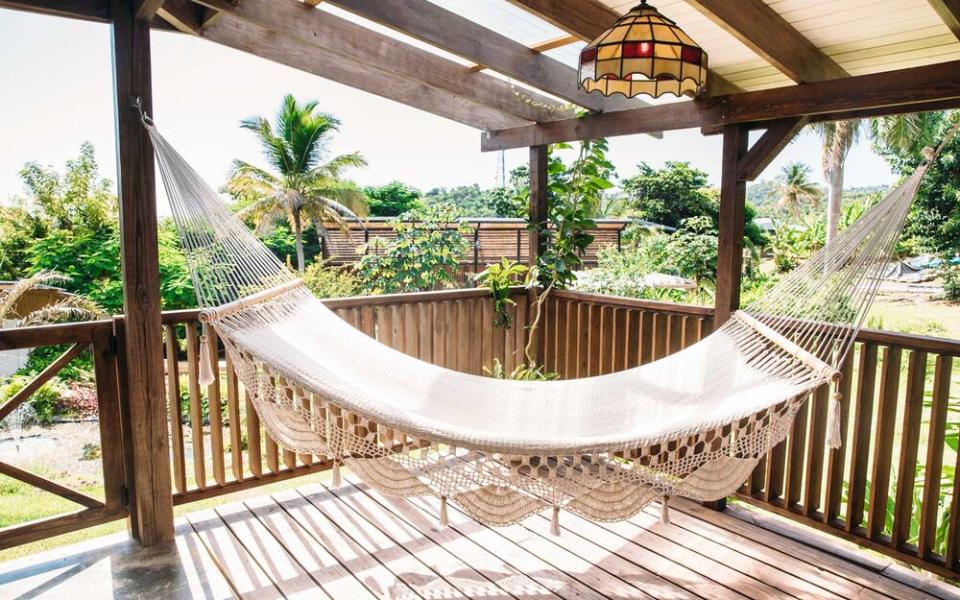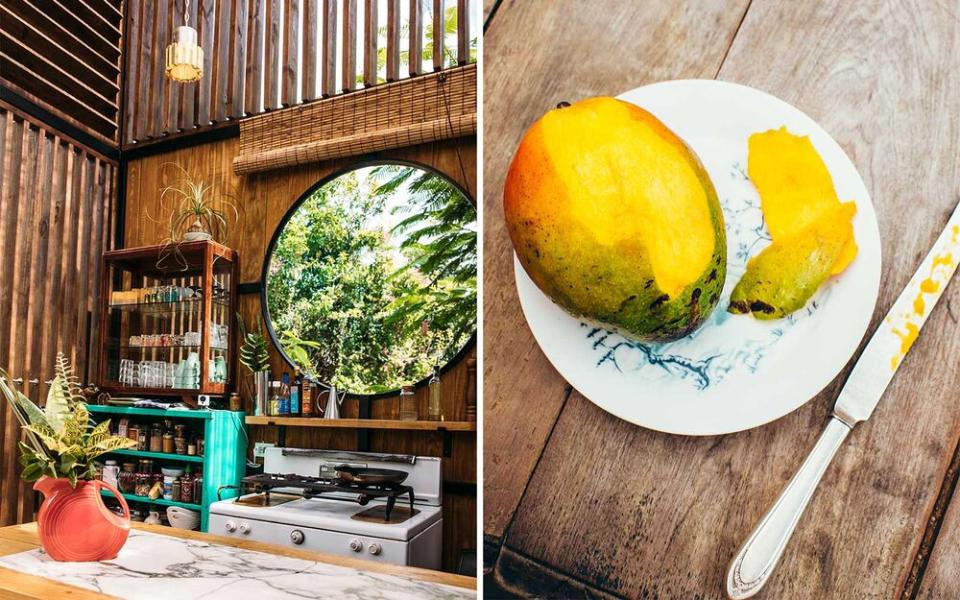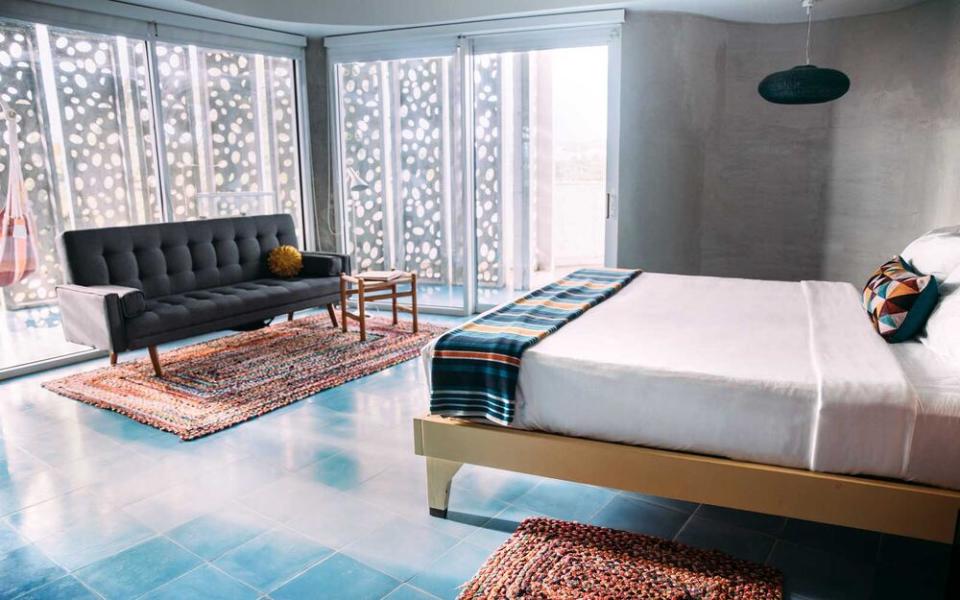Vieques, Puerto Rico Is Making a Comeback After Hurricane Maria — And Now Is the Time to Visit

I sat in the passenger seat of Sylvia De Marco's jeep as we wound uphill on a road flanked by untamed foliage. It was November of 2019, and I had just arrived on Vieques after a short but breathtaking flight from San Juan. De Marco, a designer and the proprietor of the Dreamcatcher, a hotel on the main island, acted as my unofficial guide. She had recently taken over what was left of a scrappy, 50-year-old guesthouse in the forested Vieques hills — leveled during the hurricane — and rebuilt it as La Finca Victoria, which opened last February for its inaugural season.
"The word hurricane comes from the indigenous Taíno word hurakán, 'god of the storm,'" De Marco told me. Though the memory of Maria was fresh, she dispelled the notion that disasters are in any way novel to Vieques. "This island has survived so many waves of colonialism," she explained, veering to avoid one of the many horses that run wild.

Vieques has had tumultuous history; the indigenous Taíno inhabited the island for around 500 years until the Spanish arrived violently in the 15th century. France, Britain, even Denmark all vied for control of the island for the next three hundred years until it was annexed by Puerto Rico in the early 19th century. Sugarcane production expanded and, with it, plantation slavery. When The United States took Puerto Rico after the Spanish-American war, Vieques was part of the package. As U.S. entry into World War II loomed on horizon, the Navy seized control of more than half the island, further displacing farmers and local residents, and established the base that would remain active until the Navy officially left in 2003.
I first came to Vieques in January of 2014, where I stayed at La Finca in its previous incarnation: La Finca Caribe, an isolated guesthouse owned by Washington State-based proprietor Corky Parker. (Parker bought it, in 1996, from Gail Burchard, who built it in the 1980s as a women's retreat.) Vieques had once been a sleepy place known, if at all, as an off-the-beaten-path haven for hippies and those looking to escape the rat race — and more notoriously, as a site of political turmoil: in 1999, massive demonstrations erupted in protest of the naval occupation.
During that visit, the small, densely forested island — Vieques is just 21 miles wide and 5 long, with one town each on the north and south shores — was abuzz with development, visitors flocking to its black-sand beaches and bioluminescent waters. The W, by far the largest and most luxurious hotel ever built there, had recently opened. The Modernist, 13-room Hix Island House had just expanded. Construction on El Blok — a striking concrete hotel in the town of Esperanza — was under way, and everyone was excited about its forthcoming restaurant by San Juan chef Jose Enrique.

Maria came as a punch to the gut. If Puerto Rico was abandoned after the storm, Vieques — reliant upon ferries for groceries and gasoline — was doubly so. Many residents left, unable or unwilling to rebuild. When Parker returned to clean up and reopen La Finca Caribe, she found the island in terrible shape. In a moment she describes as “total desperation and heartbreak,” she bequeathed the property to De Marco, who’d become a regular and friend over the years.
The destination is still in recovery. De Marco, and those who remained, feel a deep sense of loyalty. "Until Maria, a lot of people had forgotten the potential this island has to support the community here," she told me. "By making us vulnerable, the disaster helped us wake up."
Today, the 12-room La Finca Victoria is completely transformed under De Marco's leadership — save for the giant rubber tree still shading the walkway. There are many millennial-friendly updates: vegan breakfast and daily yoga, an honor bar with locally brewed kombucha, and a boutique market stocked with homegrown herbal teas and jewelry, clothing, and artwork by Puerto Rican women. But De Marco is more interested in cultivating long-term success and sustainability than she is in being on trend.

So is Vieques native Ivan Torres Ortiz, owner of the Crab Island Rum distillery, which De Marco took me to visit. "I wanted to stay on Vieques," he explained, in a room stacked with barrels, casks, and stainless steel drums containing his first commercial batch. "But I wanted to find work in something other than construction and bioluminescence tours. Figuring out how to make rum was the easy part."
A restless 20-something, he began tinkering, building his own stills and experimenting with recipes. But the molasses pace of local bureaucracy — as well as, of course, Maria — delayed his launch. The distillery is finally open, housed inside a former U.S. Navy firehouse in a rural green valley. Ortiz offers tastings and will soon feature pop-ups with local chefs. He hopes businesses like Crab Island can help brand Vieques as being about more than just beaches. "My product will create a lot of jobs, even if indirectly." De Marco nodded in agreement as we sipped a smooth, orange-infused rum.
While Ortiz focuses on lowering unemployment, others are imagining self-sufficiency literally from the ground up. We headed uphill, past the skeletons of once-showy homes, to La Finca Conciencia, where De Marco sources produce for her inn. This organic farm is aimed at social justice through food security and reviving local growing practices. Farmer Jorge Cora greeted us at the gate, and De Marco proceeded slowly around his terraced gardens, snipping holy basil, mustard greens, and fuchsia blossoms, pinching leaves, tasting, and asking questions. My attention was divided between the tiers of MacGyvered hives, home to Vieques's unique species of honeybees, and the stunning vista of the sea beyond. The legacy of weapons testing on Vieques means farmers sometimes face contaminated soil, but Cora's work is planting the seeds for a nascent food-autonomy movement. As a downpour broke, he packed up our crate of eggplants, and we departed.
On my last evening, I drove north from Finca Victoria, past the still-shuttered W, where vines and saplings are overtaking the whitewashed walls as nature reasserts its claim. I then cut back to Esperanza, a few square blocks of modest homes and small businesses on the southern shore. I sat on a fishing pier across from El Blok. Islanders have come to appreciate this Brutalist behemoth; the building, with its massive generator, housed relief workers and displaced locals after the storm, and became a hub for emergency services. Puerto Rican-born Carlos Perez, who became executive chef at El Blok's restaurant Placita after Jose Enrique returned to San Juan, provided thousands of free meals.
El Blok was also the first hotel to reopen after Maria, welcoming guests just two months later. Since then, the property has renewed its commitment to community engagement, moving the restaurant from the rooftop to the ground floor to welcome locals. Perez is focusing on seasonal local fare: pumpkin soup, head-on langoustines, salads of greens from La Finca Conciencia.

Esperanza is a restaurant destination for visitors to Vieques; notable spots include El Quenepo, next door to El Blok, which serves small plates and craft cocktails. (They also opened a few guestrooms last year, after what the owners called a “Hurricane Maria Renovation.") I walked down the promenade to dinner at what had become my favorite restaurant, El Guayacán, situated in an unassuming two-story cement building at the end of the Esperanza strip.
Its proprietor, Marcos Vegas Arias — who ran bars in San Juan, his hometown, for more than a decade before opening his modest restaurant on Vieques in 2013 — is a born host, and moonlights as a local tour guide. He has graciously driven me all over the island, bringing me to the most secluded beaches, including the rugged and beautiful Playa Negra: a volcanic black sand beach accessible only by hiking through a shallow riverbed.
He is also one of the few restaurant chefs on the island who serve traditional Puerto Rican home cooking: stewed chicken, tostones slathered in garlicky green sauce, vinegary conch salad. El Guayacán feels both of, and for, Vieques — a beacon of purpose that has survived both literal disaster and failed disaster management. I watched an electric-orange sun sink into the Caribbean as the musicians in the restaurant sipped Medalla Lights between sets.
A few people, reunited for another tourist season, greeted one another in Spanglish — "Hola, welcome back."
A version of this story first appeared in the February 2020 issue of Travel + Leisure under the headline Viva Vieques.
In the issue's contributors page, we erroneously referred to the writer and her husband, Chris Bradley, as the owners of the Phoenicia Diner. Mike Cioffi is the owner of the restaurant, where Bradley was chef from 2016 to 2018. Franklin, Bradley, and Cioffi collaborated on the Phoenicia Diner Cookbook, to be released later this year. We regret the error.

